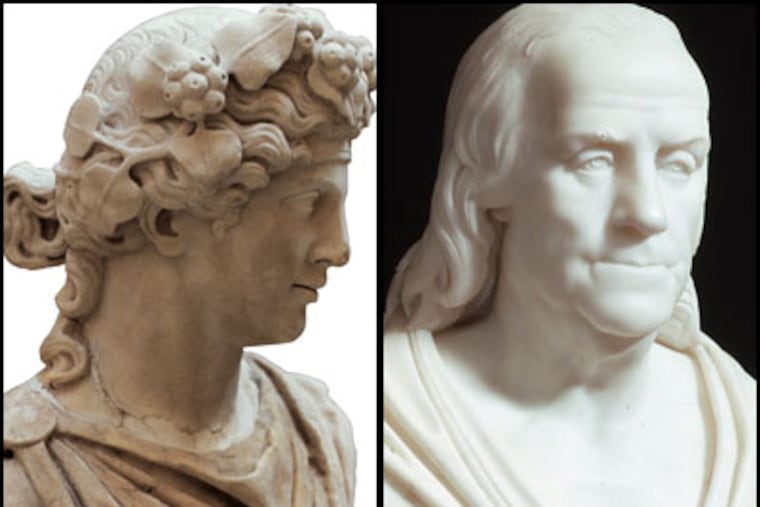Rome's stamp on America
From our money to our pro sports you can see the influence, as an exhibit at the National Constitution Center makes clear.

No such thing as Super Bowl 44.
It was, as the world knows, Super Bowl XLIV.
That buck in your pocket says Annuit coeptis ("He has approved our endeavors") and Novus ordo seclorum ("New order of the ages"). That buck and all your coins say E pluribus unum ("Out of many, one"). And at the base of that weird Masonic pyramid on the dollar? Not 1776. MDCCLXXVI.
How did all this Roman stuff get into American culture?
Because our founders were crazy about Rome and all things Roman. Rome was their model, their aim, their cautionary tale. They wanted to be - they deeply believed they were - destined to be the new Rome, to outdo Rome.
That's why the National Constitution Center offers the new exhibit "Ancient Rome & America," which opens today and runs through Aug. 1.
Strange for Rome to invade such an American place? Not. "Ancient Rome & America" tells the story of how nascent America built a new image for itself.
Created in partnership with Italy's Ministry of Cultural Heritage & Activities and Contemporanea Progetti of Florence, the exhibit started to be about "imperial Rome" - the Rome that conquered the world. "But soon we realized," says Constitution Center president David Eisner, "that it was republican Rome that was really on the minds of the founders."
The center enlisted two curatorial consultants: Caroline Winterer, associate professor of history at Stanford University, and Campbell Grey, assistant professor of classical studies at Penn.
They helped decide what stories to tell, what objects to tell them with. The exhibit features more than 300 artifacts from Italy and the United States.
Exhibit A in the exhibit: the American eagle. He's all Roman - see his many-times-great-granddad's head atop a Roman military standard. Next to a Roman bust of Bacchus circa A.D. 200 (circa for "around," A.D. for anno domini, "year of the lord"), we see a bust of George Washington in a toga, and another of our own Ben Franklin. It's a founders toga party.
The new republic (from res publica, literally "public thing" or "public affair") was a dangerous undertaking, Winterer says, and all parties knew it. "They examined Rome and its history as if it were a cadaver at an autopsy," she says. "And they examined it closely. They asked: 'What worked? What should we do? What mistakes should we avoid?' "
Grey says that "the founders deliberately appropriated images, themes and language from Rome to build up their self-image." People had their portraits painted in Roman dress. They aspired to the dignity and grandeur of the world's most famous republic.
"We look at the Supreme Court building," Winterer says, "and we say, 'Now, that's a beautiful example of American civic architecture,' when it's Roman architecture. And that's not just a footnote. That's a direct line to what we wanted to be."
Very direct. The Jefferson Memorial recalls the Roman Pantheon. Throughout D.C. all sorts of folks are wearing togas or nothing - including the notorious semi-nude Washington, not Roman but Greek-based, at the National Museum of American History. D.C. is said to have the most nude statuary of any U.S. town. Why is everyone starkers? Because the Romans copied the Greeks, and we copied the Romans.
"This country's first century, roughly 1776-1876, saw a Roman mania, with civic buildings, statues, schools, and educational curriculums much focused on Rome," Winterer says. "It's still all around us, so familiar it's invisible. The goal of this exhibit is to reimagine Rome for people so it will stop being invisible, so people see it in all the facets of their lives."
Eisner says it sure was invisible to him. "I look at that bust of Washington in a toga," he says, "and what's breathtaking is how natural it seems for him to be in a toga. And then, it's breathtaking to realize I'd never thought about it, where it came from, or what it means."
Eisner says he hopes the exhibit marks a "turning point for the Constitution Center, in which we generate new, creative exhibits of high quality, and use that to interest new partners in future projects."
Want a sine qua non ("without which not," or indispensable thing)? Or, rather, a ne plus ultra ("no more beyond," the high point)? How about this very Philadelphian connection: a helmet worn by famed Philadelphia Eagles receiver Harold Carmichael? It looks very much at home next to a real Roman gladiator's helmet.
Grey says he got the biggest kick out of the connections between Rome and American sport. "Look at a Super Bowl ticket, and it's all there," he says. "Not just the Roman numerals, but also all the gladiatorial language and culture. When you cheer at a big hit at a football game, you're putting yourself in the place of the audience at the Colosseum, begging the emperor for the thumbs down.
"When we expect our presidents to throw the first baseball in the World Series," says Grey, "we have the same expectations the Romans did of their Caesars."
Ancient Rome & America
Today through Aug. 1, National Constitution Center, 525 Arch St. Hours are 9:30 a.m.-5 p.m. Mondays through Fridays, 9:30 a.m.-6 p.m. Saturdays, noon-5 p.m. Sundays. Tickets: $20; $18 for those ages 65 and older, and $12 for children ages 4-12. Special programs and family activities will take place throughout the exhibition's run. Program times vary; check the daily activity guide upon arrival. Admission prices for the center only are $12, $8 for children ages 4-12, and $11 for those ages 62 and older, children ages 4 and younger are free. Information: 215-409-6600, 215-409-6700, www.constitutioncenter.org
EndText